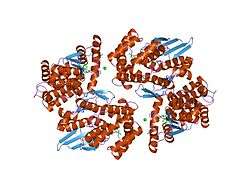Glutathione S-transferase, C-terminal domain
| Glutathione S-transferase, C-terminal domain | |||||||||
|---|---|---|---|---|---|---|---|---|---|
 | |||||||||
| Identifiers | |||||||||
| Symbol | GST_C | ||||||||
| Pfam | PF00043 | ||||||||
| InterPro | IPR004046 | ||||||||
| SCOP | 2gst | ||||||||
| SUPERFAMILY | 2gst | ||||||||
| OPM superfamily | 139 | ||||||||
| OPM protein | 1z9h | ||||||||
| CDD | cd00299 | ||||||||
| |||||||||
Glutathione S-transferase, C-terminal domain is a structural domain of glutathione S-transferase (GST).
GST conjugates reduced glutathione to a variety of targets including S-crystallin from squid, the eukaryotic elongation factor 1-gamma, the HSP26 family of stress-related proteins and auxin-regulated proteins in plants.
The glutathione molecule binds in a cleft between N and C-terminal domains. The catalytically important residues are proposed to reside in the N-terminal domain. In plants, GSTs are encoded by a large gene family (48 GST genes in Arabidopsis) and can be divided into the phi, tau, theta, zeta, and lambda classes.
Biological function and classification
In eukaryotes, glutathione S-transferases (GSTs) participate in the detoxification of reactive electrophilic compounds by catalysing their conjugation to glutathione. The GST domain is also found in S-crystallins from squid, and proteins with no known GST activity, such as eukaryotic elongation factors 1-gamma and the HSP26 family of stress-related proteins, which include auxin-regulated proteins in plants and stringent starvation proteins in Escherichia coli. The major lens polypeptide of cephalopods is also a GST.[1][2][3][4]
Bacterial GSTs of known function often have a specific, growth-supporting role in biodegradative metabolism: epoxide ring opening and tetrachlorohydroquinone reductive dehalogenation are two examples of the reactions catalysed by these bacterial GSTs. Some regulatory proteins, like the stringent starvation proteins, also belong to the GST family.[5][6] GST seems to be absent from Archaea in which gamma-glutamylcysteine substitute to glutathione as major thiol.
Oligomerization
Glutathione S-transferases form homodimers, but in eukaryotes can also form heterodimers of the A1 and A2 or YC1 and YC2 subunits. The homodimeric enzymes display a conserved structural fold. Each monomer is composed of a distinct N-terminal sub-domain, which adopts the thioredoxin fold, and a C-terminal all-helical sub-domain. This entry is the C-terminal domain.
Human proteins containing this domain
EEF1E1; EEF1G; GDAP1; GSTA1; GSTA2; GSTA3; GSTA4; GSTA5; GSTM1; GSTM2; GSTM3; GSTM4; GSTM5; GSTO1; GSTP1; GSTT1; GSTT2; GSTZ1; MARS; PGDS; PTGDS2; PTGES2; VARS;
References
- ↑ Armstrong RN (1997). "Structure, Catalytic Mechanism, and Evolution of the Glutathione Transferases". Chemical Research in Toxicology. 10 (1): 2–18. doi:10.1021/tx960072x. PMID 9074797.
- ↑ Board PG, Coggan M, Chelvanayagam G, Easteal S, Jermiin LS, Schulte GK, Danley DE, Hoth LR, Griffor MC, Kamath AV, Rosner MH, Chrunyk BA, Perregaux DE, Gabel CA, Geoghegan KF, Pandit J (2000). "Identification, Characterization, and Crystal Structure of the Omega Class Glutathione Transferases". Journal of Biological Chemistry. 275 (32): 24798–24806. doi:10.1074/jbc.M001706200. PMID 10783391.
- ↑ Dulhunty A, Gage P, Curtis S, Chelvanayagam G, Board P (2000). "The Glutathione Transferase Structural Family Includes a Nuclear Chloride Channel and a Ryanodine Receptor Calcium Release Channel Modulator". Journal of Biological Chemistry. 276 (5): 3319–3323. doi:10.1074/jbc.M007874200. PMID 11035031.
- ↑ Eaton DL, Bammler TK; Bammler (1999). "Concise review of the glutathione S-transferases and their significance to toxicology". Toxicological Sciences. 49 (2): 156–164. doi:10.1093/toxsci/49.2.156. PMID 10416260.
- ↑ Polekhina G, Board PG, Blackburn AC, Parker MW (2001). "Crystal structure of maleylacetoacetate isomerase/glutathione transferase zeta reveals the molecular basis for its remarkable catalytic promiscuity". Biochemistry. 40 (6): 1567–1576. doi:10.1021/bi002249z. PMID 11327815.
- ↑ Vuilleumier S (1997). "Bacterial glutathione S-transferases: What are they good for?". Journal of Bacteriology. 179 (5): 1431–1441. PMC 178850
 . PMID 9045797.
. PMID 9045797.
Further reading
- Nishida M, Harada S, Noguchi S, Satow Y, Inoue H, Takahashi K (1998). "Three-dimensional structure of Escherichia coli glutathione S-transferase complexed with glutathione sulfonate: Catalytic roles of Cys10 and His106". Journal of Molecular Biology. 281 (1): 135–147. doi:10.1006/jmbi.1998.1927. PMID 9680481.
- Dixon DP, Lapthorn A, Edwards R (2002). "Plant glutathione transferases". Genome Biology. 3 (3): REVIEWS3004. PMC 139027
 . PMID 11897031.
. PMID 11897031.